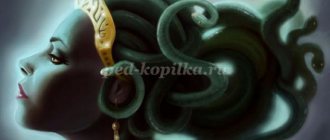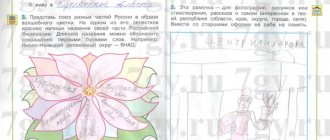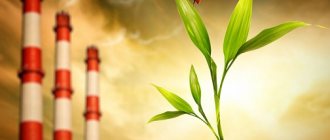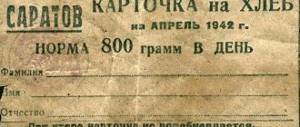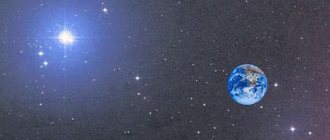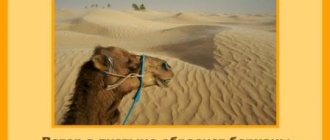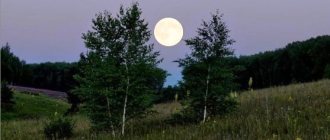The concept of "volcano"
Volcanism, a menacing, unregulated natural phenomenon, has fascinated humanity for centuries.
Volcano (from Latin vulcanus - fire, flame), a geological formation that arises above channels and cracks in the earth's crust, through which lava, ash, hot gases, water vapor and rock fragments erupt onto the earth's surface. The science that studies volcanoes is called volcanology , geomorphology.
The word "Vulcan" comes from the name of the god of Fire and blacksmith Vulcan from ancient Roman myths. This god lived underground. When he was angry, everything shook, fire and smoke flew from under the ground. Cracks formed on the surface of the earth, from which a fiery mass burst out, and everything around was covered with ash and stones.
According to Herodotus’ description, on one of the islands there is a mountain with a hole at the top, from which smoke and fire rise from time to time. The ancient Greeks believed that this was the exit (like a chimney) from the forge of the fire god, who was digging weapons deep in the depths. The Romans called it Vulcan and gave the island the name Vulcano. This island became, as it were, a model of all mountains that have the same features, because of which they began to be called volcanoes.
The structure and formation of volcanoes
When a magma chamber forms in the depths of the Earth, molten liquid magma presses from below on the tectonic plate with such force that it begins to crack. Magma moves upward along cracks and faults, melting the rock and widening the cracks. This creates an exit channel. It passes through the center of the volcano, through which molten magma pours out from the crater of the volcano to the outside in the form of fiery liquid lava.
The products of the eruption - pumice, lava, tuffs - settle on the slopes of the volcano, forming a cone. At the top of the volcano a depression forms - a crater. At the bottom of the crater you can see the crater of the volcano - the opening of the outlet channel through which ash, hot gases, water vapor, lava and rock fragments erupt. Volcano vents can be gaping - empty or filled with hot lava. If lava hardens in a crater, a plug is formed, which can only be broken through by a strong volcanic eruption, resulting in a powerful explosion.
Everything that comes out of the bowels of the Earth during a volcanic eruption is called eruption products. They are liquid, solid and gaseous. The liquid products of an eruption include lava. Lava is magma that flows onto the surface of the earth. Lava temperature is 1000°C. Fiery liquid lava spreads at speeds of up to 50 kilometers per hour, forming lava flows.
In the Hawaiian Islands, local names for two different types of lava arose: “pa-hoe-hoe” and “ah-ah.” These names are now accepted in volcanology. A pa-hoe-hoe lava flow has a smooth or slightly wrinkled surface and is composed of liquid lava. When such lava hardens, it forms a flat, smooth surface, sometimes with long wriggling wrinkles in the form of snakes and thick ropes. It is often called “rope lava”.
The "ah-ah" lava flow has an uneven surface with cracks. This lava is very thick and viscous, so the flow moves slowly. When the lava begins to cool, it cracks into pieces, but they continue to move, like clockwork on hot lava that has not yet had time to cool. The upper hardened layer of lava resembles piles of slag, which is formed from the combustion of coal.
Before a volcanic eruption, underground volcanic tremors occur. The soil under your feet begins to swell and vibrate, an underground rumble is heard, cracks appear in the ground, gases, steam, hot water are released from them, and smoke comes from the crater of the volcano. Manifestations of volcanism can be terrifying: volcanic ash erupts from the crater, covering the entire sky, it becomes dark as night for many kilometers around, rock fragments fly out with a roar, a deafening explosion is possible and, finally, fiery liquid lava pours out.
Translated from Greek, “magma” means “thick paste” or “dough.” The red-hot magma increases in volume, occupies all available space and rises from the depths of the earth along cracks, trying to break free. Magma breaks through the earth's crust in the weakest places and breaks out to the surface - flowing down the slopes in the form of lava. This is a volcanic eruption.
The composition and properties of lava erupted to the surface vary. During the eruption process, the gases contained in it are released from the magma. If gases are released calmly, and the lava is sufficiently liquid, then when it erupts, it spreads. As the magma rises along the channel, it can freeze in some area, and then “plugs” form. Large pieces of crushed plugs of solidified magma are called volcanic bombs. More viscous lava, pouring out, increases the height of the volcano, interlayering with layers of ash and debris.
If the level of magma in the magma chamber decreases, the top of the volcanic cone may fall down. This creates a huge crater called a caldera.
| Conical volcano | Shield volcano |
| Lava is thick, viscous, cools quickly | Liquid lava spreads faster |
| mountain steep slope | Mountain gentle slope |
So, usually a volcano is a mountain, in the upper part of which there is a depression - a volcanic crater, and in the thickness there is a channel called a vent. It leads to a special chamber - a magma chamber.
Magma is the molten substance of the mantle (translated from the Greek “magma” - dough, mash). It appears where the pressure is reduced and the hot mantle cannot remain in a solid state. This usually occurs near plate boundaries. Therefore, the areas of greatest distribution of volcanoes coincide with seismically active areas.
An eruption begins when a lot of magma accumulates in the source, and it rushes up the vent and pours out onto the earth's surface. Magma poured onto the surface is called lava. Its temperature reaches 1000 degrees Celsius.
Sometimes very viscous lava can solidify in the channel, forming a plug. However, after some time, the pressure from below pushes it out, and a strong eruption occurs with the release of stone blocks into the air - volcanic bombs .
During an eruption, not only lava comes to the surface, but also various gases, water vapor, volcanic dust, and clouds of ash. Ash and dust are carried by the wind for hundreds and thousands of kilometers.
Let's start the craft
It’s very easy to make an active volcano at home. For the surface of the volcano, you can use not only plasticine, but also salt dough or paper. The main secret is the chemical interaction of soda and vinegar. To make the “eruption” process more interesting, you can add a natural dye. But first things first. First you need to understand how a real volcano works.
Before starting the craft, it is recommended to look at pictures and diagrams of the structure of the volcano, as well as documentary photographs, with the children. After all, such a project is not so much developing imagination and motor skills as it is educational. Children can learn a lot about the structure of the Earth and natural phenomena.
Here is the basic cross-sectional diagram of the volcano:
As you can see from the picture, magma rises through a thin vent before exiting and becoming lava. Therefore, in order for the experiment with a volcano to work at home, you need to create the same conditions: a wide reservoir for the “magma” and a narrow neck as a vent.
It is most convenient to construct a home volcano from plasticine and a bottle. In addition to these materials you will also need:
- large format plywood or thick cardboard (approximately 50x50 cm or more);
- acrylic paints and brushes;
- scotch;
- dishwashing liquid;
- soda;
- food coloring (red or orange);
- vinegar.
Plywood is needed for the base. It can be replaced with an unnecessary basin, tray or tray. The main thing is that the size of the volcano does not exceed the size of the base. The mountain should rise approximately 20 cm from the edges of the plywood.
Let's look at the process of creating a volcano step by step.
- We form the “mouth” of the volcano. To do this, you need a bottle that can be used entirely or reduced to the desired size (depending on the height of the future volcano).
Related article: How to make an icon from a photograph with your own hands - decoupage method
To create a small model, it is better to trim the bottle, i.e. cut off the top part with the neck and the bottom part with the bottom and combine these two parts with tape. After this, the bottle can also be secured on all sides in the center of the base with tape.
- We begin to sculpt the mountain. For this, most likely, you will need a lot of plasticine. You can collect all the remains, include damaged plasticine and old figures into the total mass. The color of the volcano should be brown, gray and black, so mixing several colors will give just the right shade. It is better to knead it very well before sculpting.
The formation of a mountain begins from the bottom up. First, the base is fixed, and then plasticine is gradually applied on top, in layers. The volcano does not have to be perfectly smooth, as if taken from a potter’s wheel. On the contrary, relief and irregularities will add more realism. You can even lay gutters through which the “magma” will then flow.
Here are some photos of volcanoes made from plasticine:
From above, when the plasticine mountain is ready, you can make an imitation of flowing lava. For this you need yellow, orange and red plasticine. The pieces are combined into one lump, but are not mixed so that multi-colored stains are visible.
At the end, the craft can be treated with stacks and, if desired, painted.
- We paint the plywood with acrylic paints around the volcano and make a landscape. To do this, you can use ready-made models of dinosaurs, palm trees, and trees.
- After the craft has dried, you can begin testing. To do this, the following mixture is made:
- 1 tbsp. spoon of dishwashing detergent;
- 1 tbsp. spoon of soda;
- a few drops (5-10) of liquid food coloring.
Pour the resulting mixture into the volcano through a funnel. After this, vinegar is added to the “mouth” and a chemical reaction begins. Vinegar must be added gradually until the reaction begins (foam appears). For a bottle with a volume of 2 liters, you need to fill in ¾ cup of vinegar.
Article on the topic: Weaving baubles from ribbons: diagram with photos and video tutorials
If there is no liquid dye, you can use dry dye, but then it must be dissolved in vinegar. This is an additional component to give the foam the lava color. For a simple experiment, you can do without dye.
A model of a volcano would be a great project for a school exhibition or a geography homework project. It can be used to demonstrate the eruption or as an exhibition piece.
At home, children can play with such a volcano during the “Mesozoic era,” when dinosaurs walked the earth and volcanic eruptions were a common occurrence.
You can see how a plasticine volcano works in a selection of videos.
Classification of volcanoes
All volcanoes can be divided into the following types.
In shape - conical and shield, central and cracked.
Volcanoes appear in different ways. It turns out that it depends on how lava appears and how quickly it cools.
Central - erupting from the central hole.
Fissures - which look like gaping cracks or a series of small cones.
If the lava is thick and viscous, then it cools quickly, forming a high mountain with steep slopes, shaped like a cone. Such volcanoes are called conical.
More liquid lava spreads faster, cools slower, so it has time to flow over longer distances. The slopes of such volcanoes are gentle. This is a shield volcano.
By activity - active, asleep, extinct
Active (active) are those that erupt more or less regularly.
An active, or active, volcano is considered to be a volcano that has erupted hot rock, ash, gases and stones during a historical period of time. The most active volcano in the world is Kilauea on the island of Hawaii in the Pacific Ocean. It has been erupting continuously since 1983 and spews out lava at a rate of 5 cubic meters per second. Klyuchevaya Sopka volcano on the Kamchatka Peninsula, Fuji in Japan.
Dormant (dormant) are volcanoes that have retained their shape, but have never erupted in human memory; they can still come to life. They show signs of life: they can smoke - smoke comes from the crater, hot springs gush out. The longer a dormant volcano remains dormant, the more dangerous it is.
The Elbrus volcano in the Caucasus is covered with glaciers and has not erupted for millennia. But on its slopes there are outlets of volcanic gases, which means that volcanic activity continues.
Extinct are those that have stopped erupting completely. True, extinct volcanoes can sometimes wake up unexpectedly. The hearth beneath them has long gone out, and they themselves are so badly destroyed that only geological research reveals traces of ancient volcanic activity. In Scotland, Edinburgh Castle was built on a volcano that died out 340 million years ago. This group includes the Caucasus volcanoes – Big and Small Ararat.
However, there is no consensus among volcanologists on how to define an active volcano. The period of volcanic activity can last from several months to several million years. Many volcanoes exhibited volcanic activity tens of thousands of years ago, but are not considered active today.
By location - terrestrial, underwater, subglacial
Underwater volcanoes are those that erupt on the ocean floor and can generate waves above them that come ashore as destructive tsunamis. The volcano, located at the bottom of the Atlantic Ocean in the Canary Islands, again threw pieces of magma to the surface in November 2011. From a depth of 300 meters from the bottom of the sea near the island of El Hierro, magma began to emerge from cracks.
It turns out that all of Iceland is a volcanic island. And with each new eruption it continues to grow.
Subglacial volcanoes are located under ice caps. When such volcanoes erupt, the ice caps melt and the lava that is at the top flows down, thus leveling the surface and creating a flat top. For example, the Icelandic subglacial volcano Katla, in the south of Iceland. Recently, in the northern part of Lake Tuia, a national park was formed - Tuia Mountains. It was created in order to preserve a rare landscape with subglacial volcanoes.
Making a paper volcano
For this type of production, it is necessary to use the following types of materials:
- newspapers or magazines;
- a sheet of cardboard, or better yet plywood;
- tape for connection, preferably double-sided;
- plastic bottle;
- flour;
- paint for painting;
- scissors and brushes of different thicknesses for ease of use;
- vinegar and baking soda.
It is quite possible to make a volcano at home, but you must follow the recommendations as closely as possible . You need to create a homemade volcano in stages:
Take a sheet of cardboard or plywood and place a plastic bottle on its center. Using double-sided tape, connect the neck of the bottle to the plywood to form a cone;- Next, sheets from newspapers and magazines will help. The crumpled sheets must be placed inside the cone. This way you will get a formed figure;
- Additionally, cover the cone with double-sided tape;
- It is necessary to compact the structure of the future volcano. For this action it is necessary to create a so-called adhesive mixture. This composition includes flour and water in a ratio of 1:2. Parents, while doing this work, give their children the task of cutting strips of paper. It is important to have wet and dry rags or wipes on hand to eliminate mistakes. When everything is ready, you need to cover the volcano with these strips all the way to its crater. Then you will need to wait until the structure is completely dry. If you want to speed up the drying process, you need to place the volcano in the oven, but not at a high temperature;
- For now, the volcano is colorless and completely unattractive to children. The best way to eliminate this problem is through coloring, where it is also necessary to involve children. In this process, children develop various creative abilities and also have fun. The optimal colors would be red, green, brown and gray. Color the slide. And at its foot it is necessary to apply the color of the vegetation, that is, green. To complement this, you can draw a river there, but for this you will need an additional blue color. The body of the volcano itself should be made in brown and gray colors. In the places of the tubercles it is necessary to draw in red, depicting it as flowing lava;
- You should try making a volcano from baking soda, which is of great interest to children. In this case, you will need to use a little “magic” to bring the volcano into action. You need to prepare this magical mixture with your own hands. Warm water is poured into the neck of the bottle. This liquid must be mixed with detergent and liquid soap. Two tablespoons of soda are poured into the neck. Separately, you need to pour vinegar into a glass and color it red with paint or food coloring. It is recommended to use no more than 200 ml of vinegar per half bottle of water. Next, the colored vinegar is poured into the bottle;
- After this, the corresponding sounds of hissing and seething will be heard from the volcano. And also in a few seconds lava will appear. This action will take place for several minutes, during which the children will have time to rejoice.
What threat does the volcano pose?
“Living like on a volcano” means being in constant danger.
For people living in the vicinity of volcanoes, this is not a metaphor, but a harsh reality. What threat does a volcano pose to humans? In 79, Mount Vesuvius erupted in Italy. Three cities were buried under a layer of ash, lava and boiling mud: Pompeii, Herculaneum and Stabiae. 10 thousand people died that day.
In August 1883, one of the most famous and powerful volcanic eruptions occurred in Indonesia on the island of Krakatoa (altitude 800 m), the echoes of this event were heard even 3500 km away. Tens of thousands of people died, and the ashes thrown into the air circled the globe twice. Everywhere there was a strong clouding of the atmosphere, and the morning and evening dawns were unusually bright. And this was repeated for a whole year.
Ash makes it difficult for aircraft to move. For example, during the eruption of the Bezymyanny volcano in Kamchatka in 1956, ash was thrown to a height of 45 km.
The eruption of underwater volcanoes leads to the generation of a wave - a tsunami.
Protecting the population from volcanoes
The volcano emits gases, liquids and solids with high temperatures. This often causes the destruction of buildings and loss of life. Lava and other hot erupted substances flow down the slopes of the mountain and burn out everything they meet on their way, causing innumerable casualties and staggering material losses.
Modern science predicts volcanic eruptions quite accurately. Almost every active volcano has stations or instruments that make it possible to monitor the life of the fiery mountain. The harbingers of an eruption are volcanic earthquakes, which are associated with the pulsation of magma moving up the supply channel. Special instruments record changes in the slope of the earth's surface near volcanoes.
Before an eruption, the local magnetic field and the composition of volcanic gases released from places where volcanic gases reach the Earth's surface change. In areas of active volcanism, special stations and points have been created where continuous monitoring of volcanoes is carried out. A reliable system is being organized to alert the management bodies of industrial enterprises and the population about the threat of a volcanic eruption.
At the foot of volcanoes, the construction of enterprises, residential buildings, roads and railways is prohibited, and blasting operations are prohibited. The most reliable way to protect the population from the consequences of a volcanic eruption is evacuation. If you receive a signal about the threat of a volcanic eruption, you must immediately leave the building and arrive at the evacuation point.
What benefits does a volcano give to humans?
My class survey results
| Are there any benefits from volcanic eruptions? | There is | No | I doubt |
| Number of people In % | 1 10% | 6 55 % | 4 35% |
Volcanic eruptions open a “window” into the secrets of the Earth’s interior and provide scientists with reliable information about the composition and properties of substances located at considerable depths. In our country, the only Institute of Volcanology in the world, which is located in Petropavlovsk-Kamchatsky, is studying volcanoes.
People have long appreciated the high, incomparable fertility of volcanic soils formed on the basis of volcanic ash. Ash is a fertilizer, the basis of fertile soils. It is the fertility of the soil that attracts people to volcanic areas.
Volcanoes are “suppliers” of many minerals, such as soda, sulfur, boric acid, and cinnabar.
Pumice (volcanic lava) is included in some toothpastes as a thermal insulation backfill in construction. Pumice blocks, which are extracted from quarries in Italy, are supplied to the world market as an abrasive material for grinding.
Sapphires, silver, gold - all this can be mined from volcanic rocks. Some of the largest diamonds were also found in them.
In the history of the Earth, volcanic activity played a huge role in the formation of rocks such as basalt and tuff (compressed ash), which are used as building materials.
Volcanoes created many ore deposits. For example, the largest copper deposit, Kounradskoye in Kazakhstan, is located in the crater of an ancient volcano. In the Andes, a belt stretches for several thousand kilometers, rich in reserves of copper, tin, molybdenum, gold, silver, antimony and other minerals.
Geothermal springs are associated with volcanoes. People have long learned to use them in their economic activities.
Geysers are gushing hot springs. Why do geysers occur where there are volcanoes? Magma comes close to the surface, heats the underground waters, which begin to gush. There is a small village called Geyser in Iceland. In its surroundings, nature puts on a daily performance. The same one, day after day, three hours a day. Something amazing is happening.
At the same time, a fountain of water shoots up from the ground tens of meters high. It is enveloped in steam because the water is not just hot, but boiling. The phenomenon was called a “geyser” after the name of the place. It is found near volcanoes and other places on earth, although not very often. There is a geyser in the USA, New Zealand, and Kamchatka.
When only gases erupt from the depths, craters - maars - form on the surface. Many such flat-bottomed funnels are located in Germany. Numerous outlets of mineral and thermal waters are associated with them. Thermal mineral water comes from almost a kilometer deep and has an outlet temperature of 20-39 degrees. thermal waters are rich in have a beneficial effect on your health . The sources may contain bromine , iodine, calcium, iron, fluorine, chlorine, magnesium, sodium and other biologically active and mineral substances.
Vulcan Experience
Having learned how volcanic eruptions occur in nature, I wanted to experience a volcanic eruption at home.
In order for magma to reach the surface of the volcano, I needed the following components:
- 1 teaspoon baking soda,
- 3 tablespoons citric acid,
- 2-3 drops of red paint (gouache can also be used),
- 5 drops of dishwashing liquid,
- test tube,
- water.
Description of the experience:
- Mix paint and a small amount of water in a test tube.
- Add soda and stir.
- Add dishwashing liquid and mix everything again
- Add citric acid and mix everything quickly
- Place the test tube on the tray
- I'm watching
- The mixture begins to foam and rise up
I succeeded!
Erupting Volcano Experience
For the next experiment, I needed plasticine (to make a volcano) and lava (vinegar, red paint, liquid detergent).
Description of the experience:
- I sculpted a volcano out of plasticine in the shape of a cone.
- Prepared lava. Mixed 1/3 cup of vinegar, red paint and a drop of liquid detergent to make the volcano foam better. I took the vinegar very carefully so as not to get it on my hands (body).
- The volcano placed it on a large tray so that the lava would not spread over the table.
- I poured 2 tablespoons of soda into the mouth.
- Poured the prepared lava into the volcano.
- I observe: first a hissing is heard, then brightly colored foam begins to flow out of the “vent”.
And this experience was a success. I liked it better because it was more spectacular.
My favorite experience is “Volcano Model”
For a practical demonstration of the volcano I needed:
- Earth,
- flask,
- soda,
- dishwashing liquid,
- gouache paints (red and yellow),
- food vinegar.
And here it is, a volcanic eruption!
Conclusion
So, my assumption that the volcano is a terrible dragon living underground, which wakes up from time to time and shoots flames from its mouth, was not confirmed. Having set out to learn as much as possible about volcanoes, I discovered an amazing natural phenomenon. A volcano is a mountain with a very deep hole at its top. This is a crater. Through the hole, molten magma pours onto the surface, which forms lava, volcanic gases, and stones.
The goal of my work has been achieved! I will show colorful experiments to my classmates. Indeed, volcanoes are a miracle of nature.
There is no volcanic activity in our area. And volcanoes cannot harm us. Because an eruption is not only a beautiful sight, but also very dangerous. Volcanic eruptions are geological emergencies that can lead to natural disasters. The eruption process can last from several hours to many years.
I would like to thank everyone who helped me in creating my research work.
Everything for a child's development
We offer an unforgettable experience for children, “Volcano Eruption,” which can be easily done with your own hands at home. The chemical experiment will be especially interesting for preschoolers and elementary school children.
You can purchase a ready-made set for the experiment (on Ozon.ru, on My-shop.ru) or make a volcano from available materials that are found in every home. Let's consider two experiments.
Attention! All chemical experiments are carried out under the strict supervision of adults!
WE RECOMMEND
Salt dough volcano
Necessary materials:
- salt dough (recipe here);
- foil;
- plastic bottle;
- baking soda;
- vinegar;
- dishwashing liquid;
- food coloring (optional);
- a rimmed baking sheet or container.
How to do
Source: jugglingwithkids.com
Cut a plastic bottle in half.
Place the top of the bottle on a tray with the neck facing up. Cut strips of foil, wrap around the bottle and create a volcano shape.
Prepare the salt dough, roll it out, divide it into three parts and carefully place it on top of the foil.
For realism, color the volcano's mouth with red food coloring.
How to conduct an experiment
Pour two teaspoons of baking soda into the neck of the bottle and add a tablespoon of dish soap.
Pour vinegar into a glass and color with food coloring. Pour the liquid into the volcano and see thick colored foam flow from the crater. Children will be delighted by the spectacular volcanic eruption!
Colorful volcano made from soda and vinegar
Necessary materials:
- baking soda;
- vinegar;
- water;
- dishwashing liquid;
- liquid watercolor or diluted food coloring.
How to do
Source: funathomewithkids.com
To make the volcano sculpting mixture, take one cup of baking soda and mix with three tablespoons of water. To create a volcano like in the photo you will need 6 cups of soda. You can make the volcano smaller or larger.
Mix baking soda and water thoroughly and form a volcano. The correct mass for modeling should hold its shape well. Let dry for several hours.
Next, invite your child to color the volcano using a pipette and liquid watercolor.
How to conduct an experiment
Place the volcano in a container or other container with sides. Place a tablespoon of dish soap in the middle of the volcano and add a little vinegar. The reaction will not take long - thick foam will flow from the crater of the volcano with a hiss. An erupting volcano is a very exciting sight!
Books with experiences and experiments for children
(Click on the image for details).
- experiments,
- drawing

